| Listing 1 - 10 of 26 | << page >> |
Sort by
|
Book
ISBN: 0691615004 0691642575 1400856450 9781400856459 0691082901 9780691082905 9780691615004 9780691615004 9780691642574 Year: 1981 Publisher: Princeton, N.J. [Tokyo] Princeton University Press University of Tokyo Press
Abstract | Keywords | Export | Availability | Bookmark
 Loading...
Loading...Choose an application
- Reference Manager
- EndNote
- RefWorks (Direct export to RefWorks)
Mathematical No/ex, 27Originally published in 1981.The Princeton Legacy Library uses the latest print-on-demand technology to again make available previously out-of-print books from the distinguished backlist of Princeton University Press. These editions preserve the original texts of these important books while presenting them in durable paperback and hardcover editions. The goal of the Princeton Legacy Library is to vastly increase access to the rich scholarly heritage found in the thousands of books published by Princeton University Press since its founding in 1905.
Riemannian manifolds. --- Minimal surfaces. --- Surfaces, Minimal --- Maxima and minima --- Manifolds, Riemannian --- Riemannian space --- Space, Riemannian --- Geometry, Differential --- Manifolds (Mathematics) --- Differential geometry. Global analysis --- Addition. --- Analytic function. --- Branch point. --- Calculation. --- Cartesian coordinate system. --- Closed geodesic. --- Codimension. --- Coefficient. --- Compactness theorem. --- Compass-and-straightedge construction. --- Continuous function. --- Corollary. --- Counterexample. --- Covering space. --- Curvature. --- Curve. --- Decomposition theorem. --- Derivative. --- Differentiable manifold. --- Differential geometry. --- Disjoint union. --- Equation. --- Essential singularity. --- Estimation. --- Euclidean space. --- Existence theorem. --- Existential quantification. --- First variation. --- Flat topology. --- Fundamental group. --- Geometric measure theory. --- Great circle. --- Homology (mathematics). --- Homotopy group. --- Homotopy. --- Hyperbolic function. --- Hypersurface. --- Integer. --- Line–line intersection. --- Manifold. --- Measure (mathematics). --- Minimal surface. --- Monograph. --- Natural number. --- Open set. --- Parameter. --- Partition of unity. --- Pointwise. --- Quantity. --- Regularity theorem. --- Riemann surface. --- Riemannian manifold. --- Scalar curvature. --- Scientific notation. --- Second fundamental form. --- Sectional curvature. --- Sequence. --- Sign (mathematics). --- Simply connected space. --- Smoothness. --- Sobolev inequality. --- Solid torus. --- Subgroup. --- Submanifold. --- Summation. --- Theorem. --- Topology. --- Two-dimensional space. --- Unit sphere. --- Upper and lower bounds. --- Varifold. --- Weak topology.
Book
ISBN: 1400881250 Year: 2016 Publisher: Princeton, NJ : Princeton University Press,
Abstract | Keywords | Export | Availability | Bookmark
 Loading...
Loading...Choose an application
- Reference Manager
- EndNote
- RefWorks (Direct export to RefWorks)
This book introduces the theory of complex surfaces through a comprehensive look at finite covers of the projective plane branched along line arrangements. Paula Tretkoff emphasizes those finite covers that are free "ients of the complex two-dimensional ball. Tretkoff also includes background on the classical Gauss hypergeometric function of one variable, and a chapter on the Appell two-variable F1 hypergeometric function.The material in this book began as a set of lecture notes, taken by Tretkoff, of a course given by Friedrich Hirzebruch at ETH Zürich in 1996. The lecture notes were then considerably expanded by Hirzebruch and Tretkoff over a number of years. In this book, Tretkoff has expanded those notes even further, still stressing examples offered by finite covers of line arrangements. The book is largely self-contained and foundational material is introduced and explained as needed, but not treated in full detail. References to omitted material are provided for interested readers.Aimed at graduate students and researchers, this is an accessible account of a highly informative area of complex geometry.
Curves, Elliptic. --- Geometry, Algebraic. --- Projective planes. --- Unit ball. --- Riemann surfaces. --- Surfaces, Riemann --- Functions --- Ball, Unit --- Holomorphic functions --- Planes, Projective --- Geometry, Projective --- Algebraic geometry --- Geometry --- Elliptic curves --- Curves, Algebraic --- Appell hypergeometric function. --- Chern numbers. --- Euler number. --- Friedrich Hirzebruch. --- Gauss hypergeometric function. --- Gaussian curvature. --- Hermitian metric. --- Kodaira dimension. --- Mbius transformation. --- Miyaoka-Yau inequality. --- Riemann surface. --- Riemannian metric. --- algebraic geometry. --- algebraic surface. --- arithmetic monodromy group. --- b-space. --- ball "ient. --- canonical divisor class. --- complete quadrilateral. --- complex 2-ball. --- complex manifold. --- complex surface. --- covering group. --- covering space. --- differential geometry. --- divisor class group. --- divisor. --- elliptic curve. --- finite covering. --- first Chern class. --- fractional linear transformation. --- free 2-ball "ient. --- fundamental group. --- geometry. --- intersection point. --- line arrangement. --- line bundle. --- linear arrangement. --- log-canonical divisor. --- minimal surface. --- monodromy group. --- orbifold structure. --- orbifold. --- partial differential equation. --- plurigenus. --- projective plane. --- proportionality deviation. --- ramification indices. --- rational curve. --- regular point. --- signature. --- solution space. --- topological invariant. --- transversely intersecting divisor. --- triangle groups. --- weight.
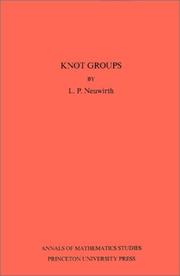
ISBN: 0691079919 1400882036 9780691079912 Year: 2016 Volume: 56 Publisher: Princeton, NJ : Princeton University Press,
Abstract | Keywords | Export | Availability | Bookmark
 Loading...
Loading...Choose an application
- Reference Manager
- EndNote
- RefWorks (Direct export to RefWorks)
The description for this book, Knot Groups. Annals of Mathematics Studies. (AM-56), Volume 56, will be forthcoming.
Topology --- 512 --- Algebra --- 512 Algebra --- Knot theory. --- Knots (Topology) --- Low-dimensional topology --- Abelian group. --- Alexander duality. --- Alexander polynomial. --- Algebraic theory. --- Algorithm. --- Analytic continuation. --- Associative property. --- Automorphism. --- Axiom. --- Bijection. --- Binary relation. --- Calculation. --- Central series. --- Characterization (mathematics). --- Cobordism. --- Coefficient. --- Cohomology. --- Combinatorics. --- Commutator subgroup. --- Complete theory. --- Computation. --- Conjugacy class. --- Conjugate element (field theory). --- Connected space. --- Connectedness. --- Coprime integers. --- Coset. --- Covering space. --- Curve. --- Cyclic group. --- Dehn's lemma. --- Determinant. --- Diagonalization. --- Diagram (category theory). --- Dimension. --- Direct product. --- Equivalence class. --- Equivalence relation. --- Euclidean space. --- Euler characteristic. --- Existential quantification. --- Fiber bundle. --- Finite group. --- Finitely generated module. --- Frattini subgroup. --- Free abelian group. --- Fundamental group. --- Geometry. --- Group ring. --- Group theory. --- Group with operators. --- Hausdorff space. --- Homeomorphism. --- Homology (mathematics). --- Homomorphism. --- Homotopy group. --- Homotopy. --- Identity matrix. --- Inner automorphism. --- Interior (topology). --- Intersection number (graph theory). --- Knot group. --- Linear combination. --- Manifold. --- Mathematical induction. --- Monomorphism. --- Morphism. --- Morse theory. --- Natural transformation. --- Non-abelian group. --- Normal subgroup. --- Orientability. --- Permutation. --- Polynomial. --- Presentation of a group. --- Principal ideal domain. --- Principal ideal. --- Root of unity. --- Semigroup. --- Simplicial complex. --- Simply connected space. --- Special case. --- Square matrix. --- Subgroup. --- Subset. --- Summation. --- Theorem. --- Three-dimensional space (mathematics). --- Topological space. --- Topology. --- Torus knot. --- Transfinite number. --- Trefoil knot. --- Trichotomy (mathematics). --- Trivial group. --- Triviality (mathematics). --- Two-dimensional space. --- Unit vector. --- Wreath product.
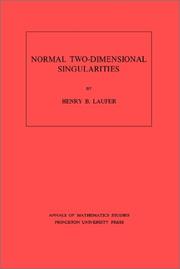
ISBN: 069108100X 1400881749 9780691081007 Year: 1971 Volume: 71 Publisher: Princeton : Princeton University Press,
Abstract | Keywords | Export | Availability | Bookmark
 Loading...
Loading...Choose an application
- Reference Manager
- EndNote
- RefWorks (Direct export to RefWorks)
A survey, thorough and timely, of the singularities of two-dimensional normal complex analytic varieties, the volume summarizes the results obtained since Hirzebruch's thesis (1953) and presents new contributions. First, the singularity is resolved and shown to be classified by its resolution; then, resolutions are classed by the use of spaces with nilpotents; finally, the spaces with nilpotents are determined by means of the local ring structure of the singularity.
Algebraic geometry --- Analytic spaces --- SINGULARITIES (Mathematics) --- 512.76 --- Singularities (Mathematics) --- Geometry, Algebraic --- Spaces, Analytic --- Analytic functions --- Functions of several complex variables --- Birational geometry. Mappings etc. --- Analytic spaces. --- Singularities (Mathematics). --- 512.76 Birational geometry. Mappings etc. --- Birational geometry. Mappings etc --- Analytic function. --- Analytic set. --- Analytic space. --- Automorphism. --- Bernhard Riemann. --- Big O notation. --- Calculation. --- Chern class. --- Codimension. --- Coefficient. --- Cohomology. --- Compact Riemann surface. --- Complex manifold. --- Computation. --- Connected component (graph theory). --- Continuous function. --- Contradiction. --- Coordinate system. --- Corollary. --- Covering space. --- Dimension. --- Disjoint union. --- Divisor. --- Dual graph. --- Elliptic curve. --- Elliptic function. --- Embedding. --- Existential quantification. --- Factorization. --- Fiber bundle. --- Finite set. --- Formal power series. --- Hausdorff space. --- Holomorphic function. --- Homeomorphism. --- Homology (mathematics). --- Intersection (set theory). --- Intersection number (graph theory). --- Inverse limit. --- Irreducible component. --- Isolated singularity. --- Iteration. --- Lattice (group). --- Line bundle. --- Linear combination. --- Line–line intersection. --- Local coordinates. --- Local ring. --- Mathematical induction. --- Maximal ideal. --- Meromorphic function. --- Monic polynomial. --- Nilpotent. --- Normal bundle. --- Open set. --- Parameter. --- Plane curve. --- Pole (complex analysis). --- Power series. --- Presheaf (category theory). --- Projective line. --- Quadratic transformation. --- Quantity. --- Riemann surface. --- Riemann–Roch theorem. --- Several complex variables. --- Submanifold. --- Subset. --- Tangent bundle. --- Tangent space. --- Tensor algebra. --- Theorem. --- Topological space. --- Transition function. --- Two-dimensional space. --- Variable (mathematics). --- Zero divisor. --- Zero of a function. --- Zero set. --- Variétés complexes --- Espaces analytiques
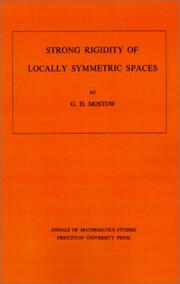
ISBN: 0691081360 1400881838 9780691081366 Year: 1973 Volume: 78 Publisher: Princeton : Princeton University Press,
Abstract | Keywords | Export | Availability | Bookmark
 Loading...
Loading...Choose an application
- Reference Manager
- EndNote
- RefWorks (Direct export to RefWorks)
Locally symmetric spaces are generalizations of spaces of constant curvature. In this book the author presents the proof of a remarkable phenomenon, which he calls "strong rigidity": this is a stronger form of the deformation rigidity that has been investigated by Selberg, Calabi-Vesentini, Weil, Borel, and Raghunathan.The proof combines the theory of semi-simple Lie groups, discrete subgroups, the geometry of E. Cartan's symmetric Riemannian spaces, elements of ergodic theory, and the fundamental theorem of projective geometry as applied to Tit's geometries. In his proof the author introduces two new notions having independent interest: one is "pseudo-isometries"; the other is a notion of a quasi-conformal mapping over the division algebra K (K equals real, complex, quaternion, or Cayley numbers). The author attempts to make the account accessible to readers with diverse backgrounds, and the book contains capsule descriptions of the various theories that enter the proof.
Differential geometry. Global analysis --- Riemannian manifolds --- Symmetric spaces --- Rigidity (Geometry) --- 512 --- Lie groups --- Geometric rigidity --- Rigidity theorem --- Discrete geometry --- Spaces, Symmetric --- Geometry, Differential --- Manifolds, Riemannian --- Riemannian space --- Space, Riemannian --- Manifolds (Mathematics) --- Groups, Lie --- Lie algebras --- Topological groups --- Algebra --- Lie groups. --- Riemannian manifolds. --- Symmetric spaces. --- Rigidity (Geometry). --- 512 Algebra --- Addition. --- Adjoint representation. --- Affine space. --- Approximation. --- Automorphism. --- Axiom. --- Big O notation. --- Boundary value problem. --- Cohomology. --- Compact Riemann surface. --- Compact space. --- Conjecture. --- Constant curvature. --- Corollary. --- Counterexample. --- Covering group. --- Covering space. --- Curvature. --- Diameter. --- Diffeomorphism. --- Differentiable function. --- Dimension. --- Direct product. --- Division algebra. --- Ergodicity. --- Erlangen program. --- Existence theorem. --- Exponential function. --- Finitely generated group. --- Fundamental domain. --- Fundamental group. --- Geometry. --- Half-space (geometry). --- Hausdorff distance. --- Hermitian matrix. --- Homeomorphism. --- Homomorphism. --- Hyperplane. --- Identity matrix. --- Inner automorphism. --- Isometry group. --- Jordan algebra. --- Matrix multiplication. --- Metric space. --- Morphism. --- Möbius transformation. --- Normal subgroup. --- Normalizing constant. --- Partially ordered set. --- Permutation. --- Projective space. --- Riemann surface. --- Riemannian geometry. --- Sectional curvature. --- Self-adjoint. --- Set function. --- Smoothness. --- Stereographic projection. --- Subgroup. --- Subset. --- Summation. --- Symmetric space. --- Tangent space. --- Tangent vector. --- Theorem. --- Topology. --- Tubular neighborhood. --- Two-dimensional space. --- Unit sphere. --- Vector group. --- Weyl group. --- Riemann, Variétés de --- Lie, Groupes de --- Geometrie differentielle globale --- Varietes riemanniennes
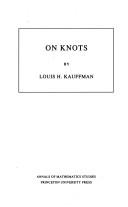
ISBN: 0691084343 0691084351 1400882133 9780691084343 Year: 1987 Volume: 115 Publisher: Princeton : Princeton University Press,
Abstract | Keywords | Export | Availability | Bookmark
 Loading...
Loading...Choose an application
- Reference Manager
- EndNote
- RefWorks (Direct export to RefWorks)
On Knots is a journey through the theory of knots, starting from the simplest combinatorial ideas--ideas arising from the representation of weaving patterns. From this beginning, topological invariants are constructed directly: first linking numbers, then the Conway polynomial and skein theory. This paves the way for later discussion of the recently discovered Jones and generalized polynomials. The central chapter, Chapter Six, is a miscellany of topics and recreations. Here the reader will find the quaternions and the belt trick, a devilish rope trick, Alhambra mosaics, Fibonacci trees, the topology of DNA, and the author's geometric interpretation of the generalized Jones Polynomial.Then come branched covering spaces, the Alexander polynomial, signature theorems, the work of Casson and Gordon on slice knots, and a chapter on knots and algebraic singularities.The book concludes with an appendix about generalized polynomials.
Knot theory --- Knots (Topology) --- Low-dimensional topology --- Knot theory. --- Algebraic topology --- 3-sphere. --- Addition theorem. --- Addition. --- Alexander polynomial. --- Algebraic variety. --- Algorithm. --- Ambient isotopy. --- Arf invariant. --- Basepoint. --- Bijection. --- Bilinear form. --- Borromean rings. --- Bracket polynomial. --- Braid group. --- Branched covering. --- Chiral knot. --- Chromatic polynomial. --- Cobordism. --- Codimension. --- Combination. --- Combinatorics. --- Complex analysis. --- Concentric. --- Conjecture. --- Connected sum. --- Conway polynomial (finite fields). --- Counting. --- Covering space. --- Cyclic group. --- Dense set. --- Determinant. --- Diagram (category theory). --- Diffeomorphism. --- Dimension. --- Disjoint union. --- Disk (mathematics). --- Dual graph. --- Elementary algebra. --- Embedding. --- Enumeration. --- Existential quantification. --- Exotic sphere. --- Fibration. --- Formal power series. --- Fundamental group. --- Geometric topology. --- Geometry and topology. --- Geometry. --- Group action. --- Homotopy. --- Integer. --- Intersection form (4-manifold). --- Isolated singularity. --- Jones polynomial. --- Knot complement. --- Knot group. --- Laws of Form. --- Lens space. --- Linking number. --- Manifold. --- Module (mathematics). --- Morwen Thistlethwaite. --- Normal bundle. --- Notation. --- Obstruction theory. --- Operator algebra. --- Pairing. --- Parity (mathematics). --- Partition function (mathematics). --- Planar graph. --- Point at infinity. --- Polynomial ring. --- Polynomial. --- Quantity. --- Rectangle. --- Reidemeister move. --- Remainder. --- Root of unity. --- Saddle point. --- Seifert surface. --- Singularity theory. --- Slice knot. --- Special case. --- Statistical mechanics. --- Substructure. --- Summation. --- Symmetry. --- Theorem. --- Three-dimensional space (mathematics). --- Topological space. --- Torus knot. --- Trefoil knot. --- Tubular neighborhood. --- Underpinning. --- Unknot. --- Variable (mathematics). --- Whitehead link. --- Wild knot. --- Writhe. --- Variétés topologiques --- Topologie combinatoire --- Theorie des noeuds
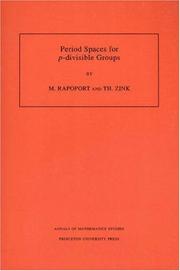
ISBN: 0691027811 1400882605 9780691027814 Year: 1996 Volume: 141 Publisher: Princeton (N.J.): Princeton university press
Abstract | Keywords | Export | Availability | Bookmark
 Loading...
Loading...Choose an application
- Reference Manager
- EndNote
- RefWorks (Direct export to RefWorks)
In this monograph p-adic period domains are associated to arbitrary reductive groups. Using the concept of rigid-analytic period maps the relation of p-adic period domains to moduli space of p-divisible groups is investigated. In addition, non-archimedean uniformization theorems for general Shimura varieties are established. The exposition includes background material on Grothendieck's "mysterious functor" (Fontaine theory), on moduli problems of p-divisible groups, on rigid analytic spaces, and on the theory of Shimura varieties, as well as an exposition of some aspects of Drinfelds' original construction. In addition, the material is illustrated throughout the book with numerous examples.
p-adic groups --- p-divisible groups --- Moduli theory --- 512.7 --- Theory of moduli --- Analytic spaces --- Functions of several complex variables --- Geometry, Algebraic --- Groups, p-divisible --- Group schemes (Mathematics) --- Groups, p-adic --- Group theory --- Algebraic geometry. Commutative rings and algebras --- 512.7 Algebraic geometry. Commutative rings and algebras --- p-divisible groups. --- Moduli theory. --- p-adic groups. --- Abelian variety. --- Addition. --- Alexander Grothendieck. --- Algebraic closure. --- Algebraic number field. --- Algebraic space. --- Algebraically closed field. --- Artinian ring. --- Automorphism. --- Base change. --- Basis (linear algebra). --- Big O notation. --- Bilinear form. --- Canonical map. --- Cohomology. --- Cokernel. --- Commutative algebra. --- Commutative ring. --- Complex multiplication. --- Conjecture. --- Covering space. --- Degenerate bilinear form. --- Diagram (category theory). --- Dimension (vector space). --- Dimension. --- Duality (mathematics). --- Elementary function. --- Epimorphism. --- Equation. --- Existential quantification. --- Fiber bundle. --- Field of fractions. --- Finite field. --- Formal scheme. --- Functor. --- Galois group. --- General linear group. --- Geometric invariant theory. --- Hensel's lemma. --- Homomorphism. --- Initial and terminal objects. --- Inner automorphism. --- Integral domain. --- Irreducible component. --- Isogeny. --- Isomorphism class. --- Linear algebra. --- Linear algebraic group. --- Local ring. --- Local system. --- Mathematical induction. --- Maximal ideal. --- Maximal torus. --- Module (mathematics). --- Moduli space. --- Monomorphism. --- Morita equivalence. --- Morphism. --- Multiplicative group. --- Noetherian ring. --- Open set. --- Orthogonal basis. --- Orthogonal complement. --- Orthonormal basis. --- P-adic number. --- Parity (mathematics). --- Period mapping. --- Prime element. --- Prime number. --- Projective line. --- Projective space. --- Quaternion algebra. --- Reductive group. --- Residue field. --- Rigid analytic space. --- Semisimple algebra. --- Sheaf (mathematics). --- Shimura variety. --- Special case. --- Subalgebra. --- Subgroup. --- Subset. --- Summation. --- Supersingular elliptic curve. --- Support (mathematics). --- Surjective function. --- Symmetric bilinear form. --- Symmetric space. --- Tate module. --- Tensor algebra. --- Tensor product. --- Theorem. --- Topological ring. --- Topology. --- Torsor (algebraic geometry). --- Uniformization theorem. --- Uniformization. --- Unitary group. --- Weil group. --- Zariski topology.
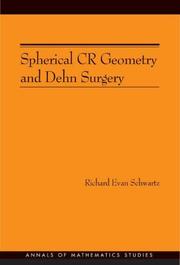
ISBN: 069112809X 1400837197 0691128103 9780691128108 9781400837199 9780691128092 Year: 2007 Publisher: Princeton Princeton University Press
Abstract | Keywords | Export | Availability | Bookmark
 Loading...
Loading...Choose an application
- Reference Manager
- EndNote
- RefWorks (Direct export to RefWorks)
This book proves an analogue of William Thurston's celebrated hyperbolic Dehn surgery theorem in the context of complex hyperbolic discrete groups, and then derives two main geometric consequences from it. The first is the construction of large numbers of closed real hyperbolic 3-manifolds which bound complex hyperbolic orbifolds--the only known examples of closed manifolds that simultaneously have these two kinds of geometric structures. The second is a complete understanding of the structure of complex hyperbolic reflection triangle groups in cases where the angle is small. In an accessible and straightforward manner, Richard Evan Schwartz also presents a large amount of useful information on complex hyperbolic geometry and discrete groups. Schwartz relies on elementary proofs and avoids "ations of preexisting technical material as much as possible. For this reason, this book will benefit graduate students seeking entry into this emerging area of research, as well as researchers in allied fields such as Kleinian groups and CR geometry.
CR submanifolds. --- Dehn surgery (Topology). --- Three-manifolds (Topology). --- CR submanifolds --- Dehn surgery (Topology) --- Three-manifolds (Topology) --- Mathematics --- Physical Sciences & Mathematics --- Geometry --- 3-manifolds (Topology) --- Manifolds, Three dimensional (Topology) --- Three-dimensional manifolds (Topology) --- Cauchy-Riemann submanifolds --- Submanifolds, CR --- Low-dimensional topology --- Topological manifolds --- Surgery (Topology) --- Manifolds (Mathematics) --- Arc (geometry). --- Automorphism. --- Ball (mathematics). --- Bijection. --- Bump function. --- CR manifold. --- Calculation. --- Canonical basis. --- Cartesian product. --- Clifford torus. --- Combinatorics. --- Compact space. --- Conjugacy class. --- Connected space. --- Contact geometry. --- Convex cone. --- Convex hull. --- Coprime integers. --- Coset. --- Covering space. --- Dehn surgery. --- Dense set. --- Diagram (category theory). --- Diameter. --- Diffeomorphism. --- Differential geometry of surfaces. --- Discrete group. --- Double coset. --- Eigenvalues and eigenvectors. --- Equation. --- Equivalence class. --- Equivalence relation. --- Euclidean distance. --- Four-dimensional space. --- Function (mathematics). --- Fundamental domain. --- Geometry and topology. --- Geometry. --- Harmonic function. --- Hexagonal tiling. --- Holonomy. --- Homeomorphism. --- Homology (mathematics). --- Homotopy. --- Horosphere. --- Hyperbolic 3-manifold. --- Hyperbolic Dehn surgery. --- Hyperbolic geometry. --- Hyperbolic manifold. --- Hyperbolic space. --- Hyperbolic triangle. --- Hypersurface. --- I0. --- Ideal triangle. --- Intermediate value theorem. --- Intersection (set theory). --- Isometry group. --- Isometry. --- Limit point. --- Limit set. --- Manifold. --- Mathematical induction. --- Metric space. --- Möbius transformation. --- Parameter. --- Parity (mathematics). --- Partial derivative. --- Partition of unity. --- Permutation. --- Polyhedron. --- Projection (linear algebra). --- Projectivization. --- Quotient space (topology). --- R-factor (crystallography). --- Real projective space. --- Right angle. --- Sard's theorem. --- Seifert fiber space. --- Set (mathematics). --- Siegel domain. --- Simply connected space. --- Solid torus. --- Special case. --- Sphere. --- Stereographic projection. --- Subgroup. --- Subsequence. --- Subset. --- Tangent space. --- Tangent vector. --- Tetrahedron. --- Theorem. --- Topology. --- Torus. --- Transversality (mathematics). --- Triangle group. --- Union (set theory). --- Unit disk. --- Unit sphere. --- Unit tangent bundle.
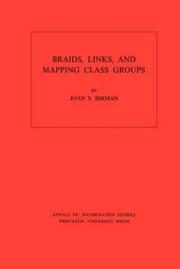
ISBN: 0691081492 1400881420 9780691081496 Year: 1975 Volume: 82 Publisher: Princeton : Princeton University Press,
Abstract | Keywords | Export | Availability | Bookmark
 Loading...
Loading...Choose an application
- Reference Manager
- EndNote
- RefWorks (Direct export to RefWorks)
The central theme of this study is Artin's braid group and the many ways that the notion of a braid has proved to be important in low-dimensional topology.In Chapter 1 the author is concerned with the concept of a braid as a group of motions of points in a manifold. She studies structural and algebraic properties of the braid groups of two manifolds, and derives systems of defining relations for the braid groups of the plane and sphere. In Chapter 2 she focuses on the connections between the classical braid group and the classical knot problem. After reviewing basic results she proceeds to an exploration of some possible implications of the Garside and Markov theorems.Chapter 3 offers discussion of matrix representations of the free group and of subgroups of the automorphism group of the free group. These ideas come to a focus in the difficult open question of whether Burau's matrix representation of the braid group is faithful. Chapter 4 is a broad view of recent results on the connections between braid groups and mapping class groups of surfaces. Chapter 5 contains a brief discussion of the theory of "plats." Research problems are included in an appendix.
Braid theory --- Braids, Theory of --- Theory of braids --- Braid theory. --- Algebraic topology --- Knot theory --- Representations of groups --- 512.54 --- Group representation (Mathematics) --- Groups, Representation theory of --- Group theory --- Knots (Topology) --- Low-dimensional topology --- 512.54 Groups. Group theory --- Groups. Group theory --- Knot theory. --- Representations of groups. --- Addition. --- Alexander polynomial. --- Algebraic structure. --- Automorphism. --- Ball (mathematics). --- Bijection. --- Braid group. --- Branched covering. --- Burau representation. --- Calculation. --- Cartesian coordinate system. --- Characterization (mathematics). --- Coefficient. --- Combinatorial group theory. --- Commutative property. --- Commutator subgroup. --- Configuration space. --- Conjugacy class. --- Corollary. --- Covering space. --- Dehn twist. --- Determinant. --- Diagram (category theory). --- Dimension. --- Disjoint union. --- Double coset. --- Eigenvalues and eigenvectors. --- Enumeration. --- Equation. --- Equivalence class. --- Exact sequence. --- Existential quantification. --- Faithful representation. --- Finite set. --- Free abelian group. --- Free group. --- Fundamental group. --- Geometry. --- Group (mathematics). --- Group ring. --- Groupoid. --- Handlebody. --- Heegaard splitting. --- Homeomorphism. --- Homomorphism. --- Homotopy group. --- Homotopy. --- Identity element. --- Identity matrix. --- Inclusion map. --- Initial point. --- Integer matrix. --- Integer. --- Knot polynomial. --- Lens space. --- Line segment. --- Line–line intersection. --- Link group. --- Low-dimensional topology. --- Mapping class group. --- Mathematical induction. --- Mathematics. --- Matrix group. --- Matrix representation. --- Monograph. --- Morphism. --- Natural transformation. --- Normal matrix. --- Notation. --- Orientability. --- Parity (mathematics). --- Permutation. --- Piecewise linear. --- Pointwise. --- Polynomial. --- Prime knot. --- Projection (mathematics). --- Proportionality (mathematics). --- Quotient group. --- Requirement. --- Rewriting. --- Riemann surface. --- Semigroup. --- Sequence. --- Special case. --- Subgroup. --- Submanifold. --- Subset. --- Symmetric group. --- Theorem. --- Theory. --- Topology. --- Trefoil knot. --- Two-dimensional space. --- Unimodular matrix. --- Unit vector. --- Variable (mathematics). --- Word problem (mathematics). --- Topologie algébrique
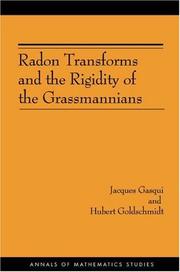
ISBN: 1282158988 9786612158988 1400826179 069111899X 0691118981 9781400826179 9780691118987 9780691118994 Year: 2004 Publisher: Princeton, N.J. Woodstock Princeton University Press
Abstract | Keywords | Export | Availability | Bookmark
 Loading...
Loading...Choose an application
- Reference Manager
- EndNote
- RefWorks (Direct export to RefWorks)
This book provides the first unified examination of the relationship between Radon transforms on symmetric spaces of compact type and the infinitesimal versions of two fundamental rigidity problems in Riemannian geometry. Its primary focus is the spectral rigidity problem: Can the metric of a given Riemannian symmetric space of compact type be characterized by means of the spectrum of its Laplacian? It also addresses a question rooted in the Blaschke problem: Is a Riemannian metric on a projective space whose geodesics are all closed and of the same length isometric to the canonical metric? The authors comprehensively treat the results concerning Radon transforms and the infinitesimal versions of these two problems. Their main result implies that most Grassmannians are spectrally rigid to the first order. This is particularly important, for there are still few isospectrality results for positively curved spaces and these are the first such results for symmetric spaces of compact type of rank ›1. The authors exploit the theory of overdetermined partial differential equations and harmonic analysis on symmetric spaces to provide criteria for infinitesimal rigidity that apply to a large class of spaces. A substantial amount of basic material about Riemannian geometry, symmetric spaces, and Radon transforms is included in a clear and elegant presentation that will be useful to researchers and advanced students in differential geometry.
Radon transforms. --- Grassmann manifolds. --- Grassmannians --- Transforms, Radon --- Differential topology --- Manifolds (Mathematics) --- Integral geometry --- Integral transforms --- Adjoint. --- Automorphism. --- Cartan decomposition. --- Cartan subalgebra. --- Casimir element. --- Closed geodesic. --- Cohomology. --- Commutative property. --- Complex manifold. --- Complex number. --- Complex projective plane. --- Complex projective space. --- Complex vector bundle. --- Complexification. --- Computation. --- Constant curvature. --- Coset. --- Covering space. --- Curvature. --- Determinant. --- Diagram (category theory). --- Diffeomorphism. --- Differential form. --- Differential geometry. --- Differential operator. --- Dimension (vector space). --- Dot product. --- Eigenvalues and eigenvectors. --- Einstein manifold. --- Elliptic operator. --- Endomorphism. --- Equivalence class. --- Even and odd functions. --- Exactness. --- Existential quantification. --- G-module. --- Geometry. --- Grassmannian. --- Harmonic analysis. --- Hermitian symmetric space. --- Hodge dual. --- Homogeneous space. --- Identity element. --- Implicit function. --- Injective function. --- Integer. --- Integral. --- Isometry. --- Killing form. --- Killing vector field. --- Lemma (mathematics). --- Lie algebra. --- Lie derivative. --- Line bundle. --- Mathematical induction. --- Morphism. --- Open set. --- Orthogonal complement. --- Orthonormal basis. --- Orthonormality. --- Parity (mathematics). --- Partial differential equation. --- Projection (linear algebra). --- Projective space. --- Quadric. --- Quaternionic projective space. --- Quotient space (topology). --- Radon transform. --- Real number. --- Real projective plane. --- Real projective space. --- Real structure. --- Remainder. --- Restriction (mathematics). --- Riemann curvature tensor. --- Riemann sphere. --- Riemannian manifold. --- Rigidity (mathematics). --- Scalar curvature. --- Second fundamental form. --- Simple Lie group. --- Standard basis. --- Stokes' theorem. --- Subgroup. --- Submanifold. --- Symmetric space. --- Tangent bundle. --- Tangent space. --- Tangent vector. --- Tensor. --- Theorem. --- Topological group. --- Torus. --- Unit vector. --- Unitary group. --- Vector bundle. --- Vector field. --- Vector space. --- X-ray transform. --- Zero of a function.
| Listing 1 - 10 of 26 | << page >> |
Sort by
|

 Search
Search Feedback
Feedback About
About Help
Help News
News